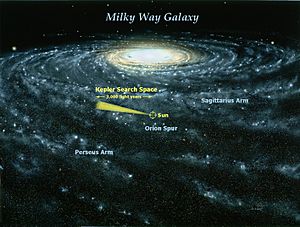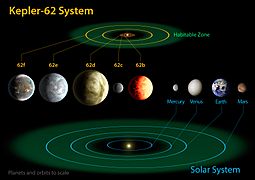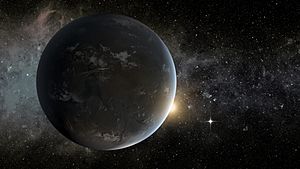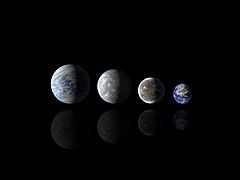Kepler-62 facts for kids
| Observation data Epoch J2000 Equinox J2000 |
|
|---|---|
| Constellation | Lyra |
| Right ascension | 18h 52m 51.0519s |
| Declination | +45° 20′ 59.400″ |
| Apparent magnitude (V) | 13.75 |
| Characteristics | |
| Evolutionary stage | Main sequence |
| Spectral type | K2V |
| B−V color index | 0.832 |
| Astrometry | |
| Proper motion (μ) | RA: −25.153±0.026 mas/yr Dec.: −31.170±0.027 mas/yr |
| Parallax (π) | 3.2947 ± 0.0134 mas |
| Distance | 990 ± 4 ly (304 ± 1 pc) |
| Details | |
| Mass | 0.69 ± 0.02 M☉ |
| Radius | 0.64 ± 0.02 R☉ |
| Luminosity | 0.21 ± 0.02 L☉ |
| Surface gravity (log g) | 4.68 ± 0.04 cgs |
| Temperature | 4925 ± 70 K |
| Metallicity [Fe/H] | −0.37 ± 0.04 dex |
| Rotation | 39.3 ± 0.6 days |
| Rotational velocity (v sin i) | 0.4 ± 0.5 km/s |
| Age | 7 ± 4 Gyr |
| Other designations | |
| Database references | |
| SIMBAD | data |
| Extrasolar Planets Encyclopaedia |
data |
Kepler-62 is a star much like our Sun, but it is a bit cooler and smaller. It is located about 990 light years away from Earth. You can find it in the constellation Lyra.
Scientists use the Kepler spacecraft to look for planets orbiting other stars. On April 18, 2013, they announced that Kepler-62 has five planets orbiting it. Two of these planets, named Kepler-62e and Kepler-62f, are especially interesting. They are in the star's habitable zone. This means they might have the right conditions for liquid water to exist on their surfaces. Kepler-62f is probably a rocky planet, similar to Earth.
Contents
How Kepler-62 Got Its Name
Before the Kepler telescope observed it, Kepler-62 had a different catalog number. It was known as 2MASS J18525105+4520595. In the Kepler Input Catalog, it was called KIC 9002278. When scientists found possible planets orbiting it, they gave it the number KOI-701. KOI stands for Kepler object of interest.
The NASA Kepler Mission looks for planets using a method called the transit method. This method involves watching for tiny dips in a star's brightness. These dips happen when a planet passes in front of its star, blocking some of its light. From Earth, it looks like the planet is "transiting" the star. Other things can cause these dips too, so at first, they are called "planetary candidates."
After the discovery was confirmed, the star was officially named "Kepler-62." This is how stars with confirmed planets found by the Kepler spacecraft are usually named. This is the name people use to talk about the star and its planets.
Planets found by the Kepler Mission are given names like ".01", ".02", and so on, after the star's name. This naming follows the order they were discovered. If several planets are found at the same time, they are named from the one with the shortest orbit to the one with the longest.
The planets around Kepler-62 are named b, c, d, e, and f. The letter b is always given to the first planet found orbiting a star, and then the other letters follow. In the Kepler-62 system, all five planets were announced at once. So, b is the planet closest to the star, and f is the farthest. Kepler-62 is the 62nd star found by Kepler to have confirmed planets.
About the Star Kepler-62
Kepler-62 is a K-type main sequence star. It is about 69% the mass of our Sun and 64% its size. Its temperature is around 4925 K. This star is very old, about 7 billion years old. To compare, our Sun is younger, at about 4.6 billion years old, and hotter, with a temperature of 5778 K.
Kepler-62 has fewer "metals" than our Sun. In astronomy, "metals" means any element heavier than hydrogen and helium. Kepler-62 has about 42% of the iron and other heavy metals found in the Sun. This is similar to another star called Kepler-442. The star's brightness is normal for its type. It shines with about 21% of the Sun's brightness.
From Earth, Kepler-62 looks very dim. Its apparent magnitude is 13.75. This means you cannot see it with your bare eyes. You would need a powerful telescope.
The Planets of Kepler-62
All five known planets of Kepler-62 "transit" the star. This means they pass in front of the star from our view on Earth. Because of this, scientists can measure how long it takes for each planet to orbit the star. They can also figure out how big the planets are compared to the star. The planets' orbits are almost perfectly circular.
The planets range in size from about half the size of Earth to nearly twice its size. The most exciting planets are e and f. These two planets are the best candidates for being solid, rocky planets in the star's habitable zone. Kepler-62e is about 1.61 times the radius of Earth, and Kepler-62f is about 1.41 times the radius of Earth. Their sizes suggest they could be rocky, like Earth.
Their location in the Kepler-62 system means they are in the "habitable zone." This is the area around a star where the temperature is just right for liquid water to exist on a planet's surface. For Kepler-62f, a lot of carbon dioxide in its atmosphere might help keep it warm enough. For Kepler-62e, a protective cloud cover could help. If these conditions are met, these planets could have oceans covering them!
Scientists have not been able to figure out the exact masses of these planets directly. However, based on models, they estimate the planets' masses are likely much lower than the maximum possible. For example, Kepler-62e might be around 4.8 Earth masses, and Kepler-62f around 2.8 Earth masses.
Gallery
See also
 In Spanish: Kepler-62 para niños
In Spanish: Kepler-62 para niños





